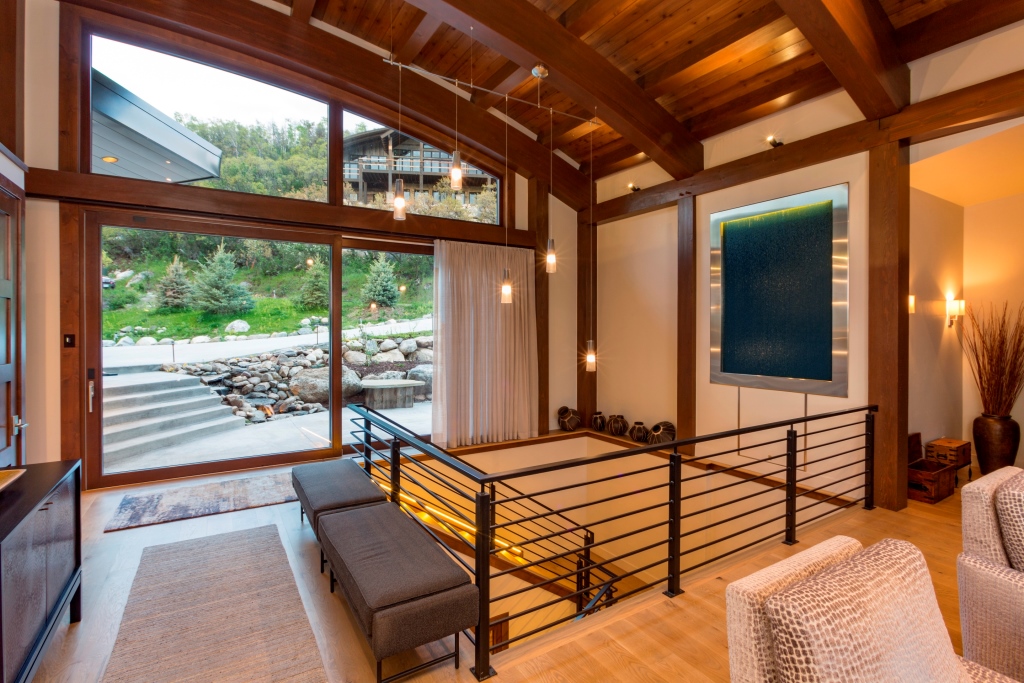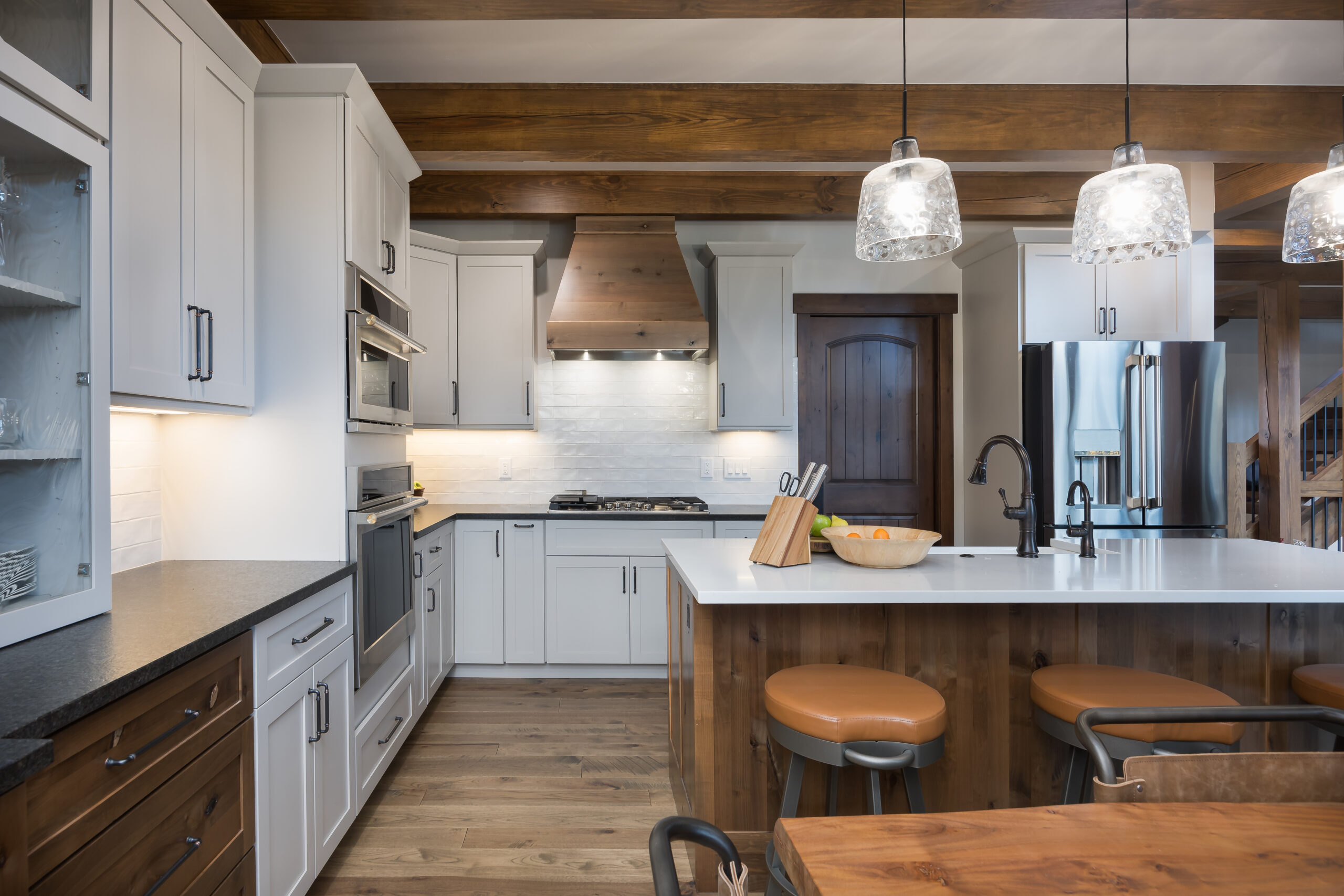Timber frame homes are inherently efficient. Double down on your home’s sustainability with these smart selections for interior materials and furnishings.
When it comes to Woodhouse timber frame structures, sustainability is simply a built-in benefit. Literally! Thanks to the use of structural insulated panel (SIPs), our timber frame buildings are able to provide lower energy costs and lighter impacts on the environment. Plus, timber frame homes actually use less wood than conventionally framed homes — despite all the gorgeous wood on display!
But that’s the big picture. After you’ve decided to pursue a timber frame home, there are still plenty of choices to make along the way that can lead you to an even healthier indoor habitat — for you and the planet.
A truly sustainable timber frame home also brings green living to the interior. Here, we explore some of the superior interior selections and design strategies that complete a sustainable timber frame home — all without sacrificing the style and sophistication our homes are known for.
Sustainable Choices
When it comes to establishing a sustainable timber frame home, it’s never too late to start. However — it’s also never too early to start planning, as it’s much easier and more cost-effective to integrate these systems into your home from the get-go. While many of these selections don’t come from Woodhouse directly, Woodhouse can help with budgeting and customize your plan to suit your desired features.
High-Performance Windows and Doors
Panoramic window walls are an iconic feature of timber frame homes. Woodhouse uses Andersen Windows with a high-performance glass that reduces heat loss during winter and heat gain during summer.
Energy Star Appliances
From your dishwasher, fridge, and freezer, to your water heater, washer, and dryer — choosing appliances engineered for efficiency saves water, energy, and lowers your bills. Look for the energy star symbol, which designates that the item has met criteria set by the EPA.
Low-Flow Water Fixtures
These are a must-have in any region prone to stretches of dry weather. Showerheads, faucets, and even toilets can save gallons of water with each use.

This Colorado home features a complete state-of-the-art home automation system that controls the home through a smartphone or tablet, including the heating and cooling, fireplaces, lighting, security, automated window treatments, shower and more.
Smart Home Systems
Home technology is getting smarter everyday. From thermostats to appliances, “smart” devices can help you save energy. You can even create an orchestrated schedule between your window shades and lighting routines, which will adjust automatically to the time of day and season to minimize energy consumption while providing the perfect lighting.
Zero-VOC and Non-Toxic Paints and Stains
Volatile organic compounds (VOCs) are found in many conventional materials, finishes, and paints. VOCs are harmful to produce and their off-gassing negatively impacts human health. Milk or chalk paints, pure linseed oils, and eco-friendly waxes are all sustainable alternatives. Many of these nourish the wood, providing protection without harsh chemicals and VOCs.
Sustainable Surfaces
Floors and counters can be made from reclaimed wood, wood certified by the Forest Stewardship Council, or sustainably-sourced bamboo and tiles. Cork is another option. True linoleum made from linseed is making a comeback as is terrazzo, which includes recycled glass and can be used as a floor, countertop, and backsplash. Taking time to find the right sustainably-sourced material will also emphasize your home’s unique style.
Quality Furniture
Similar to fast fashion, disposable furniture is choking landfills and churning through precious natural resources. Enlist the help of an interior designer to find furniture that will work with your style and last as long as your home. This may involve selecting a few high-quality, handcrafted pieces or breathing new life to consigned treasures.
Natural Fibers
Synthetic fibers contain plastics which enter the environment as microplastics. Not only are jute, hemp, wool, sisal, organic cotton, and rattan safe, natural fibers – they’re simply luxurious. These sources are renewable, and in some cases, environmentally regenerative.
Alternative Textiles
Get creative with textile sources. Leather has a beautiful feel and is natural, however, material technologies have come a long way, and today you can buy “leather” made from mushroom, cork, pineapple, coconut and even apple.
Think Local
When considering materials, don’t overlook local options for furniture, rocks, and plant sources for landscaping. These choices support the local community and reduce carbon output involved in transportation.
Start with Small Swaps
From coffee to candles, there are always ways to step up your commitment to reducing your consumer waste footprint. Start by swapping out say, just five items for more sustainable alternatives. Think: forest-free toilet paper, microfiber cloths instead of paper towels, low-tox cleaning supplies, organic food, compost bins, and so on. There are loads of options, so choose what works best for your lifestyle and interest.
From Dream to Design
Does this sound like goals you have for your own future dream home? Explore our gallery and floor plans for ideas and inspiration. Or start with a conversation about your goals and contact your Woodhouse Regional Project Manager.








